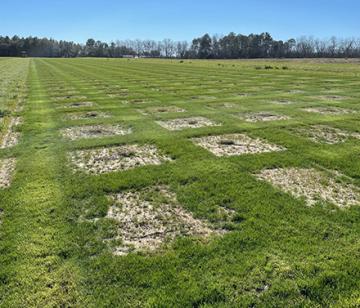Grass: Life’s All-Purpose Carpet

Researchers planted centipedegrass for a field trial with annual ryegrass around each field plot to prevent erosion. (Karen Harris-Schultz, D4922-1)
Rural or Suburban, Turfgrass Covers all the Bases
When the term “grassland” comes up, most people think of the Great Plains or vast prairies. While accurate, that’s not the whole story: in fact, you enter grasslands nearly every time you step outside.
One of the most prevalent forms of grassland in the U.S. is the kind covered by turfgrass – the grass found on a home lawn, golf course, or athletic field. “Any grass that acts as a groundcover, is usually mowed or kept short, and endures traffic can be a turfgrass,” said Shaun Bushman, a geneticist with ARS’s Forage and Range Research Laboratory in Logan, UT.
Many of ARS’s grass research programs are based on improving forage for livestock, but Bushman’s project focuses on the social side of things. “From picnics to playgrounds, and football fields to roadsides, turfgrasses play a role in human health and well-being,” he said. “Our project’s success depends on the ability of turfgrasses to retain these roles and functions while using fewer resources, such as water, fertilizer, herbicides, and pesticides.”
ARS has been involved in turfgrass research for decades, focusing on seed production, disease resistance, and more. According to Bushman, retaining turf function with less water has been a growing priority for the past 15 years. He and other ARS scientists who work with turfgrasses have formed a consortium to share ideas, methods, and resources, including colleagues from Beltsville, MD; Raleigh, NC; Tifton, GA; Logan; Maricopa, AZ; Woodward, OK; and Corvallis, OR.
“We use digital imagery and environmental sensors to characterize turfgrasses in the field and in greenhouses, genomic sequencing to identify gene functions and locations, high-throughput genotyping methods to track mutations of interest, and recurrent selection to improve turfgrasses over time,” he said.
Manicured lawns and playing fields offer a lot more than something nice to look at, though: “They provide cooling effects, erosion control, water filtration, and, of course, playing surfaces for human health,” said Scott Warnke, research plant geneticist with the ARS Floral and Nursery Plants Research Unit at the National Arboretum in Washington, DC. “Turfgrasses are the only plants capable of absorbing the stresses that exist in areas where they are used while being able to recover quickly from those stresses.”
They are also unique, according to Bushman, in that they persist over the years despite being continually cut and stepped on. “Their genomes are fascinating; full of repeat regions, redundancy, and variation, all of which aid them in adapting to the stresses that are imposed upon them.”
Given all these benefits, the ARS scientists are working hard to protect and enhance turfgrass in the face of changing conditions. Looking at the long term, Warnke pointed out that, “Developing new varieties that have improved tolerance to drought, pests, or other climactic stresses is important for the long-term sustainability of turfgrasses.” – By Scott Elliott, ARS Office of Communications
You May Also Like

